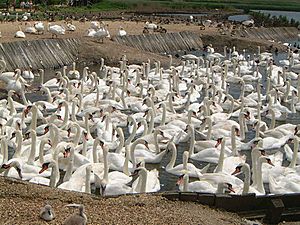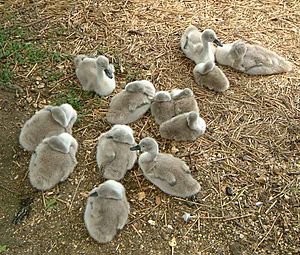Abbotsbury Swannery facts for kids
The Abbotsbury Swannery is a special place in Dorset, England. It's the only place in the world where a large group of mute swans live and nest together, managed by people. It's found near the village of Abbotsbury, close to the sea. This amazing home for swans is next to the Fleet Lagoon. This lagoon is a calm area of water, safe from the strong winds of Lyme Bay.
Hundreds of swans live here, sometimes over 600! About 150 pairs of swans build their nests and raise their young. People have been looking after swans here for a very long time. Records show it existed in 1393, but it might have started even earlier. Many believe Benedictine monks first set it up in the 1000s.
Contents
The History of Abbotsbury Swannery
How the Swannery Began
The Fleet Lagoon formed after the last ice age ended. Melting ice created shallow, salty water behind Chesil Beach. Many plants grew there, making it a perfect home for wild birds. In the 1000s, Benedictine monks built the St. Peter's monastery nearby. King Cnut gave the land to his steward, Orc. The monks then managed the swans. They used the swans as a source of meat for their big feasts.
From Monks to Modern Owners
The monks continued to use the swannery until 1539. This was when King Henry VIII closed down many monasteries. The old monastery buildings are still visible near the Church of St. Nicholas. After the monastery closed, Sir Guy Strangeways bought the land. His family, the Strangeways, have owned it ever since. Today, Mrs Charlotte Townshend owns the estate. She is a descendant of the first Countess of Ilchester.
Abbotsbury Swannery Today
Exploring the Swannery and Lagoon
The Fleet Lagoon is the biggest lagoon in Europe. It stretches for about 13 kilometers (8 miles) along the Dorset coast. The water is a mix of fresh and salt water, and it has tides. Chesil Beach protects it from the open sea. This area is very important for nature. It is a Ramsar site and a Site of Special Scientific Interest. It has been a nature reserve since 1393. The swannery is at the western end of this special lagoon.
Abbotsbury Swannery is now a popular place for visitors. The swans are used to people being around. You can get quite close to them, even when they are nesting. Before seeing the swans, you can visit the Decoyman's House. This house explains how the swan colony has been managed. It also shows how the swannery has changed over time.
Amazing Wildlife at the Swannery
Besides the swans, many other water birds visit the Fleet and Chesil Beach. Over 300 different types of birds have been seen here. This is why the area has special protections. It is a Site of Special Scientific Interest (SSSI). It is also a Special Protected Area (SPA). And it is a Special Area of Conservation (SAC).
Swan Behavior and Daily Life
Normally, nesting mute swans are very protective of their space. So, it's unusual to see so many pairs nesting close together. Sometimes, young cygnets might get confused. They might try to follow the wrong parent swan. To help with this, some families get special pens. These pens give them more privacy.
A fun part of visiting is the daily feeding sessions. These happen at noon and 4 p.m. Many swans gather around for food. Children are often invited to help feed them.
The Swan Round-Up
Around late July, the swans lose their flight feathers. This means they cannot fly for about six weeks. This is called moulting. Every two years, the swans are gathered together. This "round-up" helps people check on them. They are examined, weighed, and measured. Any new swans get a special ring on their leg. About 50 canoes help with the round-up. They start at one end of the lagoon. They slowly guide the swans into the swannery bay. In the past, over 900 birds have been counted during a round-up. The number changes each year.
Today, there are about 600 swans at Abbotsbury. They are free to fly anywhere they want. But they clearly love the Fleet Lagoon. Visitors can walk on small paths among the nests. Sometimes, the swans might show off their protective side. The swannery is open from March to the end of October. A great time to visit is from mid-May to late June. This is when you can see the young cygnets.
Categories



